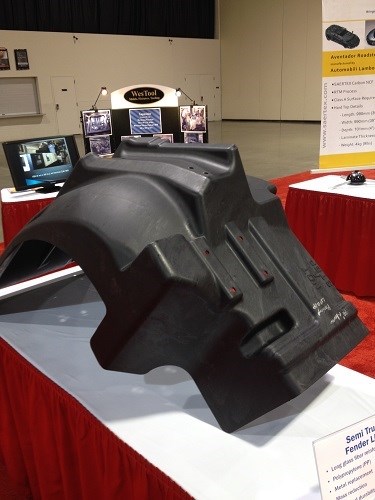Thermoplastic Composites Prominent At SPE's ACCE
Advances in long fiber thermoplastics (LFT) starred in several presentations and exhibits.
Last week in Novi, Mich., I attended SPE’s Automotive Composites Conference & Exhibition (ACCE) and was impressed by the daily panel discussions, including one on lightweighting and the multi-material car. Moderated by president and CEO Jay Baron of the Center for Automotive Research (CAR), it featured panelists from Ford, GM, Magna, Gurit Automotive, and EDAG Engineering AG.
Among the highlights of the discussion:
• Lightweighting in automotive is an enabling tool to deliver fuel economy and performance, and not something consumers care about.
• The greatest advantage of plastic composites currently is also their greatest disadvantage: that they are so infinitely tailorable.
• The composites industry would do well to take cues from the steel industry which has aligned itself with the automotive industry and identified the development of new materials.
• The steel industry seems to reinvent itself every 10 years and the third generation steel grades allow for making low-cost parts with tenfold the strength of previous generations. As such, we can expect a rather stable presence of low-cost, high-performance steel in automotive, even in the most composite-intensive vehicles.
• Ford’s new aluminum-intensive F-150 truck will demonstrate a significant step in weight reduction, but this can be achieved by other materials.
• There is great potential for carbon fiber reinforced plastics as new materials are developed, the cost is dropped, and parts are designed for these materials.
• By the same token, we are not likely to see high-volume, composite-intensive vehicles on the road for a while.
Also impressive was the broad range of presentations on developments in both thermoset and thermoplastic composites. A “star” emerging in the thermoplastics composites arena is long fiber thermoplastics (LFT). Advances with LFT were discussed by suppliers of materials like Invista and DuPont, suppliers of glass fiber reinforcements Owens-Corning and PPG, carbon fiber supplier Zoltec, as well injection molding machine maker Arburg, and the Fraunhofer Institute. In the exhibit hall, compounder PlastiComp, which specializes in LFT, showcased a semitruck fender liner made of LFT-PP, which outperformed a failed short glass fiber part and replaced metal, resulting in mass reduction and increased durability (see photo).
Stay tuned for an upcoming article in PT on these and other interesting developments in thermoplastic composites. These include advances in thermoplastics reinforced with carbon nanotubes (CNTs), high-impact nylons reinforced with a new nanoadditive that are promising for use with FDM additive manufacturing technology, and new generation boron nitride nanotube continuous fibers that show potential to surpass in mechanical properties CNTs and possibly graphite fibers.

Related Content
-
Melt Flow Rate Testing–Part 1
Though often criticized, MFR is a very good gauge of the relative average molecular weight of the polymer. Since molecular weight (MW) is the driving force behind performance in polymers, it turns out to be a very useful number.
-
Fundamentals of Polyethylene – Part 6: PE Performance
Don’t assume you know everything there is to know about PE because it’s been around so long. Here is yet another example of how the performance of PE is influenced by molecular weight and density.
-
Improving Twin-Screw Compounding of Reinforced Polyolefins
Compounders face a number of processing challenges when incorporating a high loading of low-bulk-density mineral filler into polyolefins. Here are some possible solutions.








.png;maxWidth=300;quality=90)







